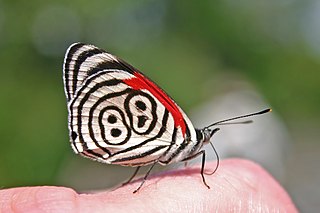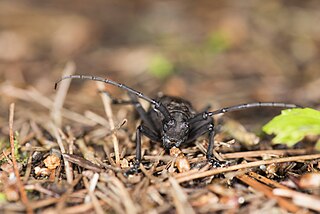Related Research Articles
Aethalops is a genus of megabats in the family Pteropodidae. It contains two species:

Ceryx is a genus of moths in the family Erebidae. It was described by Hans Daniel Johan Wallengren in 1863.

Diaethria is a brush-footed butterfly genus found in the Neotropical realm, ranging from Mexico to Paraguay.
Similodonta is an extinct genus of early bivalve in the extinct family Praenuculidae. The genus is one of eleven genera in the subfamily Praenuculinae. Similodonta is known from Middle Ordovician through Middle Silurian fossils found in Europe and North America. The genus currently contains eight accepted species, Similodonta ceryx, Similodonta collina, Similodonta djupvikensis, Similodonta magna, Similodonta recurva, Similodonta spjeldnaesi, Similodonta wahli and the type species Similodonta similis.
Ceryx affinis is a moth of the subfamily Arctiinae. It was described by Rothschild in 1910. It is found in New Guinea.
Ceryx antiopa is a moth of the subfamily Arctiinae. It was described by Sergius G. Kiriakoff in 1953. It is found in the Democratic Republic of the Congo.
Ceryx basilewskyi is a moth of the family Erebidae. It was described by Sergius G. Kiriakoff in 1955. It is found in Burundi.
Ceryx burgeffi is a moth of the subfamily Arctiinae. It was described by Obraztsov in 1949. It is found on Java.
Ceryx calcuni is a moth of the subfamily Arctiinae. It was described by Obraztsov in 1957. It is found on Java.
Ceryx diptera is a moth of the subfamily Arctiinae. It was described by Johan Christian Fabricius in 1775. It is found in southern India and Sri Lanka. In male, the body is black. Frons, collar and tegulae are yellow. Forewings with a sub-basal, two medial, one sub-apical and two sub-marginal hyaline (glass-like) spots. Hindwings with a sub-basal joined to a sub-marginal spot. Tarsi black. Female is similar to male, but differ with the abdomen dilated and with a tuft of ochreous hairs.
Ceryx evar is a moth of the subfamily Arctiinae. It was described by Pagenstecher in 1886. It is found on Ambon Island, Aru and the Key Islands.
Ceryx hageni is a moth of the subfamily Arctiinae. It was described by Snellen in 1895. It is found on Sumatra.
Ceryx helodiaphana is a moth of the subfamily Arctiinae. It was described by Roepke in 1937. It is found on Java.
Ceryx keiensis is a moth of the subfamily Arctiinae. It was described by Rothschild in 1910. It is found on the Key Islands.
Ceryx lamottei is a moth of the subfamily Arctiinae. It was described by Sergius G. Kiriakoff in 1963. It was described from Nimba.
Ceryx macgregori is a moth of the subfamily Arctiinae. It was described by Schultze in 1900. It is found on the Philippines.
Ceryx pleurasticta is a moth of the subfamily Arctiinae. It was described by George Hampson in 1901. It is found in India.
Ceryx salutator is a moth of the subfamily Arctiinae. It was described by Sergius G. Kiriakoff in 1965. It is found in the Democratic Republic of the Congo.
Ceryx sumatrensis is a moth of the subfamily Arctiinae. It was described by Obraztsov in 1949. It is found on Sumatra.

Aethalodes verrucosus is a species of beetle in the family Cerambycidae, and the only species in the genus Aethalodes. It was described by Charles Joseph Gahan in 1888.
References
- ↑ Beccaloni, G.; Scoble, M.; Kitching, I.; Simonsen, T.; Robinson, G.; Pitkin, B.; Hine, A.; Lyal, C., eds. (2003). "Ceryx aethalodes". The Global Lepidoptera Names Index . Natural History Museum . Retrieved April 28, 2018.
| This Ceryx-related article is a stub. You can help Wikipedia by expanding it. |